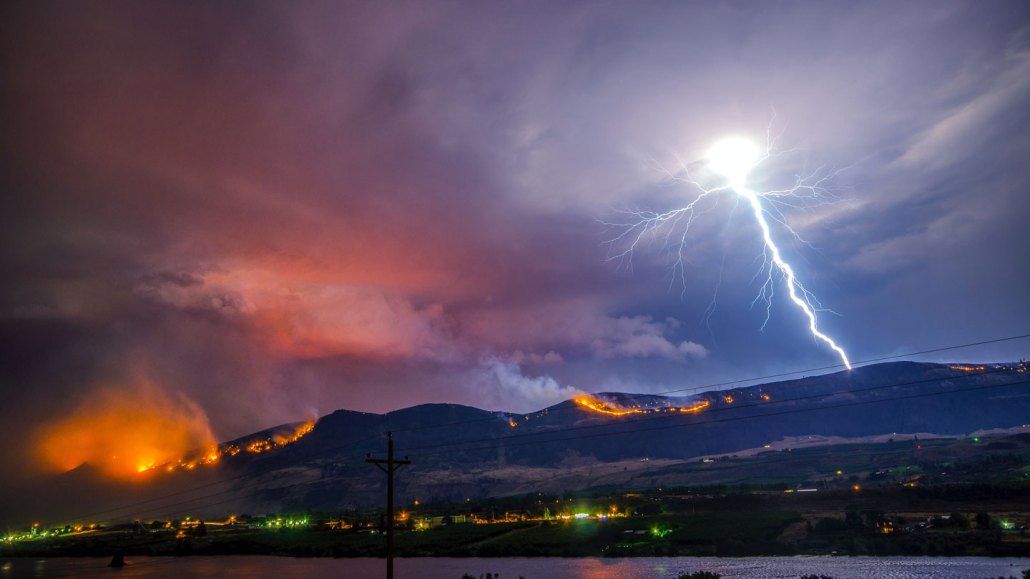
Among all the forces of nature, lightning is the most prolific fire starter, capable of sparking blazes that can threaten communities, like this one in Wenatchee, Wash. If Earth’s temperature continues to rise, there may be more incendiary flashes by the end of the century.
Frank Cone/Pexels
A form of lightning with a knack for sparking wildfires may surge under climate change.
An analysis of satellite data suggests “hot lightning” — strikes that channel electrical charge for an extended period — may be more likely to set landscapes ablaze than more ephemeral flashes, researchers report February 10 in Nature Communications. Each 1 degree Celsius of warming could spur a 10 percent increase in the most incendiary of these Promethean bolts, boosting their flash rate to about four times per second by 2090 — up from nearly three times per second in 2011.
That’s dangerous, warns physicist Francisco Javier Pérez-Invernón of the Institute of Astrophysics of Andalusia in Granada, Spain. “There will be more risk of lightning-ignited wildfires.”
Among all the forces of nature, lightning sets off the most blazes. Flashes that touch down amid minimal or no rainfall — known as dry lightning — are especially effective fire starters. These bolts have initiated some of the most destructive wildfires in recent years, such as the 2020 blazes in California (SN: 12/21/20).
But more than parched circumstances can influence a blast’s ability to spark flames. Field observations and laboratory experiments have suggested the most enduring form of hot lightning — “long continuing current lightning”— may be especially combustible. These strikes channel current for more than 40 milliseconds. Some last longer than one-third of a second — the typical duration of a human eye blink.
“This type of lightning can transport a huge amount of electrical discharge from clouds to the ground or to vegetation,” Pérez-Invernón says. Hot lightning’s flair for fire is analogous to lighting a candle; the more time a wick or vegetation is exposed to incendiary energy, the easier it kindles.
Previous research has proposed lightning may surge under climate change (SN: 11/13/14). But it has remained less clear how hot lightning — and its ability to spark wildfires — might evolve.
Pérez-Invernón and his colleagues examined the relationship between hot lightning and U.S. wildfires, using lightning data collected by a weather satellite and wildfire data from 1992 to 2018.
Long continuing current lightning could have sparked up to 90 percent of the roughly 5,600 blazes encompassed in the analysis, the team found. Since less than 10 percent of all lightning strikes during the summer in the western United States have long continuing current, the relatively high ignition count led the researchers to infer that flashes of hot lightning were more prone to sparking fire than typical bolts.
The researchers also probed the repercussions of climate change. They ran computer simulations of the global activity of lightning during 2009 to 2011 and from 2090 to 2095, under a future scenario in which annual greenhouse gas emissions peak in 2080 and then decline.
The team found that in the later period, climate change may boost updraft within thunderstorms, causing hot lightning flashes to increase in frequency to about 4 strikes per second globally — about a 40 percent increase from 2011. Meanwhile, the rate of all cloud-to-ground strikes might increase to nearly 8 flashes per second, a 28 percent increase.
After accounting for changes in precipitation, humidity and temperature, the researchers predicted wildfire risk will significantly increase in Southeast Asia, South America, Africa and Australia, and risk will go up most dramatically in North America and Europe. However, risk may decrease in many polar regions, where rainfall is projected to increase while hot lightning rates remain constant.
It’s valuable to show that risk may evolve differently in different places, says Earth systems scientist Yang Chen of the University of California, Irvine, who was not involved in the study. But, he notes, the analysis uses sparse data from polar regions, so there is a lot of uncertainty. Harnessing additional data from ground-based lightning detectors and other data sources could help, he says. “That [region is] important, because a lot of carbon can be released from permafrost.”
Pérez-Invernón agrees more data will help improve projections of rates of lightning-induced wildfire, not just in the polar regions, but also in Africa, where blazes are common but fire reports are lacking.







